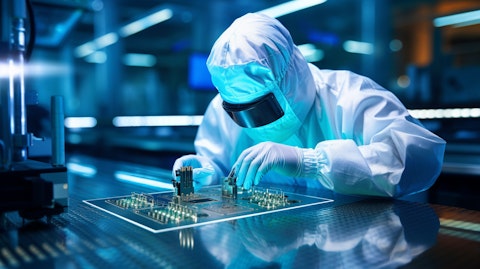Atomera Incorporated (NASDAQ:ATOM) Q1 2025 Earnings Call Transcript May 6, 2025
Atomera Incorporated misses on earnings expectations. Reported EPS is $-0.17 EPS, expectations were $-0.13.
Operator:
Mike Bishop: Hello, everyone, and welcome to Atomera’s First Quarter 2025 Update Call. I’d like to remind everyone that this call and webinar are being recorded, and a replay will be available on Atomera’s IR website for one year. I’m Mike Bishop with the Company’s Investor Relations. As in prior quarters, we’re using Zoom, and we will follow similar presentation format with participants in a listen only mode. We will open with prepared remarks from Scott Bibaud, Atomera’s President and CEO, and Frank Laurencio, Atomera’s CFO. Then we will open the call to questions. If you are joining by telephone, you may follow a slide presentation to accompany our remarks on the Events and Presentations sections of our Investor Relations page on our website.

Before we begin, I would like to remind everyone that during today’s call, we will make forward looking statements. These forward statements, whether in prepared remarks or during the Q&A session, are subject to inherent risks and uncertainties. These risks and uncertainties are detailed in the Risk Factors section of our filings with the Securities and Exchange Commission, specifically in the company’s annual report on Form 10-K filed with the SEC on March 4, 2025. Except as otherwise required by federal securities laws, Atomera disclaims any obligation to update or make revisions to such forward looking statements contained herein or elsewhere to reflect changes in expectations with regards to those events, conditions and circumstances.
Also, please note that during this call, we will be discussing non-GAAP financial measures as defined by SEC Regulation G. Reconciliations of these non-GAAP financial measures to the most directly comparable GAAP measures are included in today’s press release, which is also posted on our website. Now I would like to turn the call over to our President and CEO, Scott Bibaud. Go ahead, Scott.
Scott Bibaud: Thanks, Mike. I’d like to start out today by giving a few more details on our recent partnership announcement with a major capital equipment provider, who unfortunately has a policy against allowing their name to be used in partners’ press releases. First, let me say that we’ve had a long relationship with this equipment maker, and this agreement is something both companies have been working towards for a long time. They want to bring advanced material solutions to their customers to solve problems in the gate all around space, and we can help them do that. Atomera benefits by leveraging our partners’ detailed knowledge of these large customers’ applications, design goals, organizations, and decision makers.
Q&A Session
Follow Atomera Inc (NASDAQ:ATOM)
Follow Atomera Inc (NASDAQ:ATOM)
Receive real-time insider trading and news alerts
Ultimately, if we are both successful, Atomera will get more licensees into production faster, and our partner will sell more equipment and services to our mutual customers. Let me tell you why I’m excited about this agreement. Advanced node customers have huge teams working on multiple different aspects of each new technology node. Some working one or two or even two nodes ahead and some working on the node currently in production. Our partner has detailed insight into each of these efforts working collaboratively with their customers to find solutions in many different areas. Inevitably, customer wants to see actual silicon results to prove that the solution works. And when they get them, they ask for even more results. Each request is more detailed and specific.
Although Atomera has a very sophisticated development environment, it pales in comparison to what our partner OEMs can bring to bear and which we will be able to use to provide these more detailed tests. By doing so, we can deliver solutions to the customer that are more optimized and validated and therefore may go into production more quickly. Probably even more importantly, we will be rowing downstream with our partner on the sales and marketing side of the equation. As a small company, we do not have a large and sophisticated sales organization that can be so helpful to close designs within the complex decision making structure of these large customers. Since both of us will be driving these designs towards production, our partner company’s direct sales force will be assisting us along the way, which will be an invaluable resource to us.
Just last quarter, I talked about how Atomera’s MST technology can solve many of the problems in gate all around transistors. This partnership will help us to promote and ultimately close sales in that area. While the collaboration agreement details are confidential, I can assure you that the terms do not have a significant impact on our long standing business model of license fees and royalties. The primary benefit for both our companies in this deal is to grow the pie larger, not to take pieces of each other’s businesses. Although the stated aim of the agreement is on gate-all-around architectures, there’s little doubt the partnership will extend into advanced memories and other areas as well. Timing of this announcement coincides with the rising use of EPI in advanced logic as well as in higher performance DRAM, where [indiscernible] has been adopted.
As EPI applications are more widely embraced, the barriers to implement MST go down. The size and the growth of the epi market is therefore an indicator of the potential for MST sales, and in 2027, the EPI equipment market is expected to be approximately $2.6 billion with a CAGR in the leading edge nodes of 10% to 15%. Even before finalizing this agreement, we’ve been making significant progress in gate all around applications, generating much more detailed silicon validated performance enhancement data for customers, as well as depositing MST films on customer wafers for evaluation. We’ve established footholds in each of the gate-all-around customers that we are confident will expand over the rest of this year assisted by our new partnership.
On the memory side, we’ve been granted new patents focused on DRAM sense amplifiers, which are relevant for both high bandwidth as well as standard DDR memories. We are actively leveraging this IP into our current discussions with a large memory providers. Late in 2024, many of our RF SOI customers expressed a need to improve low noise amplifiers or LNAs in addition to our prior efforts on RF power switches. Using TCAD and silicon test result data, we determined that MST can significantly improve the performance of LNAs in RF SOI devices. Just recently, mobile phone manufacturers have started putting new emphasis on LNA improvements to meet the increasing demands of newer 5G technologies. So we are seeing widespread interest from customers.
Our presentation at RF Insize [ph] highlighted the new application and has generated lots of inbound interest. Indeed, during the last few months, we’ve worked with several different RF SOI manufacturers to start new wafer runs using our partner Soitec’s Ultra Thin RF SOI wafers to prove out these LNA benefits. With good results, we believe our customers will want to take this into production relatively quickly. Work with power customers also continues to grow with interest in new applications and voltage levels, many of which are driven by demand for AI servers. But let me share what I can on progress with our most important power customer, STMicro. During the last six months, our biggest focus with STMicro has been on optimizing manufacturability, yield, and throughput in preparation for high volume manufacturing, and we’ve made great progress here.
Our two teams are meeting together on a weekly basis as we push to get the best performance out of our efforts. Many different lots are in the fab with frequent test results indicating a clear path towards qualification. ST has not authorized me to provide additional insight into their schedule, though. One measure of ST’s regard for our technology is the interest we’ve seen from other groups within ST. Today, we are in active discussions with three other product areas in ST beyond Smart Power devices. Each of these has the potential to lead to new licenses and future royalty streams. It’s clear that Atomera’s technology focus areas have excellent overlap with ST’s overall technology strategy and direction. We believe this is a very important validation of our technology’s effectiveness coming as it does from a customer who has a deep understanding of its potential from their hands on experience.
Now a brief update on each of our licensees. We continue discussions with our JDA-1 customer about meeting new requirements they’ve raised. Of course, we recognize this effort needs to move faster, and we believe that working with our new equipment provider will help make that happen. For both our JDA-2 and Fabless licensees, we are in the process of running wafers, and we expect to see results of those later this year. Each of these companies has expressed interest in also working with us in new technology areas. Likewise, we are in discussion with our foundry licensee and we hope to start new lots with them soon. Our progress with new customers this quarter has been excellent and we continue to move forward with the two very high potential transformative customers discussed in our last call.
We are encouraged by the amount of work they want to do and the speed at which they are moving. We also started discussions with new customers in entirely new areas for us. We’re working to today to engage with them in first discussions, and hopefully that will lead to licensing and or revenue opportunities with them later this year. Previously, we’ve described our work to expand into a new product category, compound semiconductors, and more specifically, gallium nitride. As a brief refresher, gallium nitride is a wide band gap [ph] semiconductor material that supports a broad range of applications, including consumer power supplies, automotive electrification, and power electronics for AI data centers. The market for GaN in these applications is growing quickly and is forecast to exceed $2 billion at the device level by the end of the decade, growing at about a 40% CAGR.
Last year, we described exciting results from initial studies of MST improving GaN growth on silicon substrates. Customers found them interesting but asked for electrical data to demonstrate the impact at the device level. We have been working to fabricate devices And this quarter, as part of the previous announced partnership with Sandia National Labs, we completed the world’s first GaN devices produced using MST technology. This is an exciting accomplishment. Data collection from these first of kind devices is still in progress, but we are now seeing indications of improved electrical performance consistent with our previous observation of improved material quality. As would be expected from first of kind tests, there are some elements of these devices that aren’t optimized, and we’re already working on the next round with a target of a complete customer shareable data set illustrating the benefits of MST for GaN applications.
Several of our existing customers are active in GaN production, so once we have this data, we should have a ready audience. And there are other GaN foundries and IDMs that would help us expand beyond the current customer base as well. We are very excited about MSD for GaN and so are our partners. Just recently, Sandia National Labs renewed our access program so that we can do more work together. Robert Mears wrote a great article on this topic, recently published, in Compound Semiconductor Magazine, which you can find on our website. The beginning of this year has been a very busy time for us across all our markets and product areas. Work on STMicro is moving towards completion. We are seeing customer expansion in power, RF, and in other application areas, which we hope to talk about in future calls.
The work we are doing on gate all around and memory is tied directly to the biggest driver of the semiconductor industry today, the rollout of AI infrastructure, and our newly announced partnership with a major semiconductor equipment provider will help us accelerate and close license deals to take advantage. Finally, our GaN work is not only aligned with a major industry push, but we also believe it can be executed with faster time to revenue than our other segments. The workload at Atomera has gotten to the point where we are actively recruiting for staff in our engineering team focused on transition to high volume production and in our sales and marketing team focused on closing deals. With applications developing momentum in so many areas, we believe it’s only a matter of time before Atomera becomes a technology licensing powerhouse within the semiconductor industry.
Now Frank will review our financials.
Frank Laurencio: Thank you, Scott. At the close of the market today, we issued a press release announcing our results for the first quarter of 2025. This slide shows our summary financials. Our GAAP net loss for the first quarter of 2025 was $5.2 million or $0.17 per share compared to a net loss of $4.8 million or $0.19 per share in in Q1 2024. GAAP operating expenses in the first quarter of this year were $5.5 million which was an increase of $448,000 from $5 million in Q1 2024. The increase in OpEx was due to a $397,000 increase in R&D expenses, reflecting higher outsourced device fabrication services to support increased customer activity and a $277,000 increase in G&A expense, primarily due to higher legal expenses. These increases were partly offset by a $226,000 decline in sales and marketing expenses, mostly due to larger to lower headcount.
Non-GAAP net loss in Q1 2025 was $4.4 million compared to a loss of $4 million in Q1 of last year due to a $468,000 increase in non-GAAP operating expense, reflecting the same factors I just discussed. Stock compensation expense, which is the main difference between GAAP and non-GAAP operating expenses, were $1 million in both periods. Sequentially, Q1 non-GAAP net loss of $4.4 million compares to a $3.9 million loss in Q4 of 2024, primarily due to the same higher R&D and legal expenses I spoke about earlier, offset by lower sales and marketing due to headcount. Our balance of cash, cash equivalents and short term investments on March 31, 2025 was $24.1 million compared to $26.8 million on December 31, 2024. We used $4.8 million of cash in operating activities in Q1 compared to $4.1 million in Q1 2024 and $3 million in Q4 of last year.
As has been the case in prior years, cash outlays in the first quarter will be higher this year than in other quarters, reflecting payments for items that hit our P&L throughout the year. Early in Q1, we raised $2.4 million under our ATM facility by selling approximately 163,000 shares at an average price of $15.19 putting us in a comfortable cash position such that we have not needed to access the capital market during the recent volatile months. For Q2, revenue will depend on timing of wafer shipments to our fabless licensee and will be in the range of zero to $50,000. Consistent with our usual practice, we’re not providing revenue guidance any further out. The next major revenue milestone under our agreement with ST will occur when they get into formal process qualification.
Moving to expenses. On our last call, I shared that we expected non-GAAP OpEx to be in the range of $17 million to $18 million in 2025. Outsourced fabrication work, which we used to do at TSI Semiconductor, has now been spread over multiple vendors who can offer specialty services that are more specifically tuned to the range of technology areas that we’re working on. We also have had lower headcount in sales and marketing, which we’re making progress on replacing. I now expect our full year non-GAAP operating expense for 2025 will be in the range of $17.25 million to $$17.75 million. With that, I will turn the call back over to Scott for a few summary remarks before we open the call up to questions. Scott?
Scott Bibaud : Thank you, Frank. With the announcement of our new partnership as well as the progress we’ve made in the last quarter, Atomera is better positioned than ever to deliver important solutions for today’s challenging electronic devices. We’ve worked very hard to build our technology and relationships at all the large semiconductor companies, and we believe that effort will be converted into a significant and sustainable business. I appreciate your support as we work hard to turn this vision into a reality. Mike, we will now take questions.
A – Mike Bishop: Thank you, Scott. If you wish to ask a question, please click the Q&A button at the bottom of the Zoom window, then feel free to type in your question. I will do my best to aggregate the incoming queries and relay them to management. Alternatively, you can click the raise hand button, and we may call on you to ask your question live. And right now, our first question comes from Richard Shannon of Craig Hallum.
Richard Shannon: I think my first question is going to be on your announcement of I don’t know if this is early this week or last week about working with this semi-production equipment company here. I guess a few questions. Love to get a sense of, you know, what kind of equipment we’re talking about. Scott, I know in the past you’ve talked about partnering with EpiMakers, EpiMachineMakers [ph], of which there are three, I believe, that are major ones. Wondering if you can confirm whether that’s it. Maybe suggest how long you’ve been working with them to establish this sort of relationship. And maybe you can describe to the degree to which this, partner has skin in the game here to you know, that’s really kind of relaying, you know, a real commitment to working with you in this regard.
Scott Bibaud: Yes. Okay. So, you know, it’s always tricky to kind of answer the details about what tools they sell because it pretty much tells you who they are. So I think I’m going to defer a little bit on that, Richard, but I will say that it’s a technology that we use very extensively. And this customer or this partner is someone that we’ve been working closely with for many years. I think the thing I can comment the most on is your last part of the question. So, you know, there’s always in my in my remarks, I talked about how customers ask for a lot of data from us, and then then when they get that data, they ask for even more. And every time they ask for more data, it gets to be something it’s harder to test for.
It’s more expensive to set up, find the right type of wafers, process them to a certain point, and then set it up and get that very expensive testing that you need to do to be able to test at the individual transistor level. And we can do some of that ourselves, but, the big thing here is that our partner company has massively more capabilities than us. And they are, you know, just like everybody, budget constrained on what they can spend their money on. And so when we would go to them in the past and say, hey we’ve got this great customer opportunity, but we really need you to help us, you know, spend a whole bunch of time and money with your resources and your equipment and your, you know, capabilities to help us prove this for the customer, their natural reaction would be like, well, what’s in it for us?
You know? How do we know that if we do all this work for you, you aren’t going to just go to production with someone else? And so this partnership is something that we talked about for a long time where basically you said, if we’re going to be developing this technology together with them, then we’re going to we’re going to go to production with their tools on that technology. And we’re going to be upfront working with our end customers that we’re doing this on a joint basis, and so, you know, the end solution is on a joint basis. Okay. So in other words, the skin in the game that, that our partner company is adding is that they’re putting a bunch of equipment and personnel and engineering resources to help us get the data to be able to win this design and go to production, and it will be with their equipment.
Richard Shannon: Okay. And I can’t remember if you said this or not, Scott, but I just want to confirm. Is this work largely focused on leading edge, both Logic and DRAM?
Scott Bibaud: It’s focused on the gate-all-around, so leading edge. I would say whenever I talk about advanced nodes, though I always include the leading memory manufacturers because the work they’re doing is also very much bleeding edge. And so the techniques that we come up with for gate all around for logic, for example, are frequently applicable across the memories.
Richard Shannon: Okay. Fair enough. Let’s jump to another topic here, that being ST Micro here. Certainly understand you can only share what you’ve shared here so far, but an interesting comment you made was that you’ve got other areas within ST that are starting work with you. Maybe if you can you describe what other technology areas or at least describe whether there are areas that you already work with other customers? And is it fair to think and I think you said this, but I just want to make sure that these new divisions or groups within ICMEC [ph] are doing it directly because of the work that the power the Smart Power Group has already undertaken, and there’s some communication between that suggests they should be These new groups should be working on it as well.
Scott Bibaud: Yes. So answer the last part first. Absolutely. I think at the most senior levels of ST, we, at this point, have a lot of credibility. And when a group goes to the Smart Power group and says, hey we might be interested in MST for another application. What do you think? They say, absolutely. You should work with them. We’ve got a very, very good working relationship with them. If you look at overall ST as a company, you know, they’re very big company and they and they have products focused in many different areas, but the overlap with what we have is quite high. They have RF SOI products. They have gallium nitride products. They have it they have advanced node products, but not the most advanced nodes, but from, but they have something called, fully depleted SOI products, which are, as you probably know, they’re kind of, like, 28 nanometers and below focused on very low power applications.
And they’re pretty advanced technologies, that’s something that we could do a lot of work with them in. We’re working with smart power, but, but they do, power in a number of other different areas that would be overlaps with us. So, you know, there’s just enormous amount of different areas that we can engage with them with. And, yeah, we’ve a lot of this has been incoming interest. Some of it has been us reaching out and saying, hey. We know you’re working in this area and trying to, set up meetings and so forth. But a lot of it has been groups within ST who reach out to us directly and say, we understand your technology, and we think it could help us with something.
Richard Shannon: Okay. Very interesting. Thanks for that detail. Maybe touching quickly on the topic of RF SOI. I think this is probably the technology area that we’ve been talking about, for the longest. You mentioned, customers interested in in improving, the LNAs and low noise amplifiers, which I’ll be honest with you, I don’t understand that much other than I know they exist in front end modules. And you said you’ve been doing all this work in the past with power switches. Has this been kind of the limitation or a headwind to adoption by RF SOI customers in the past, and this could be that key to unlocking the opportunity here? Or are there can they be can there be other functions within the front end module that you can also impact and, therefore, you know, finally get one of these guys over the finish line?
Because it’s been, I don’t know, a number of years here, it’s one that I’ve been I’ve always thought it would be the first one to go to production, and it’s been, I guess, stubbornly not quite there. So wondering if this work here is that is that kind of catalyst to move you across the finish line.
Scott Bibaud: Yes. I think on the front end module, you know, the power switching was the key application that we were first very much focused on and where I would say there was more development effort by the RFSO guy f SOI guys than a lot of other areas. It was a way a key competitive advantage that they could have going on to the market. That isn’t to say that our technology only worked on the power switching, but that was where our biggest focus with the customers was. They we’d run wafers and we do testing in that area, and I still think that we have shown a very significant ability to improve power switching. But there is a number of other areas in the front end that are important. And what seems to have happened, and I haven’t I don’t know exactly where this came from, but I think one of the leading or maybe several of the leading mobile phone manufacturers or possibly even a mobile a large mobile phone operator has changed the specifications for their phones to say, we need far better LNA performance.
LNA is, you know, it’s a low noise amplifier. It helps you to receive signals at lower signal strengths so that you can get longer range. And it just seems like I don’t know where it came from, but all of our customers are simultaneously asking us about that. And so this seems to be a very hot area. So now we’re working with our customers not just on the power switch, but also on the LNA. And I think because there’s a demand for this and there’s going to be a competition to win those designs, I think people will move quickly.
Richard Shannon: Okay. Well, hopefully, from my personal perspective, hopefully, it’s Verizon that’s asking for these changes because I’d love to get better performance out of my house here. But probably two last questions for me, one for you and one for one for Frank. So just kind of touching again on the topic of the transformative customers. And, Scott, I do want to make sure. I know two calls ago, you talked about a transformative customer that sounded delayed, but then you mentioned two others on the last call. I think you’re referring to the ones on the last call.
Scott Bibaud: Yes I was referring to the ones on the last call.
Richard Shannon: Okay. And I don’t think I took very good notes here, so I’m going to have to ask you to repeat the kind of the call out here with that particular set of two customers there. Can you repeat that for me, please?
Scott Bibaud: Yeah. I mean, what I said earlier was that things continue to move really quickly with those guys and expansively. So they want to do a lot of work with us, and they want to do it, you know, very quickly. At least one of them is moving at a pace that I didn’t think that was going to be, I mean, they’re moving much, much faster than I expected. And the other one is also, expanding to do a lot more than we had hoped for before. So, overall, I would love for us to be able to, you know, make an agreement with these guys so we can start talking about them in some more detail but it is something that we’re quite excited about.
Richard Shannon: Okay. Does the work going on here involve the partner with the capital equipment the unnamed capital equipment company?
Scott Bibaud: So we did not get involved with these customers as part of the capital equipment company but one of the things I mentioned about that agreement is that it’s going to expand. So we did focus the agreement around gate all around. We just want to put something in place and make it more focused on parameters such that we could kind of close a deal. But I think this is going to establish a working relationship that we have together, and it’s really going to expand to include a whole bunch of our businesses, including possibly these two.
Richard Shannon: Okay. Fair enough. Frank, a quick question for you. I missed the number that you mentioned in terms of OpEx for this year, and I guess I’d love to understand kind of an exit rate for this year to think about it because it sounds like you’re looking to add headcount here, over time or based on some contingencies. I’d love to get a sense of both of those numbers, please.
Frank Laurencio: Sure. So the I gave a range last time of 17 to 18. I basically just narrowed it down to, the midpoint of that of 17 and a quarter to 17 and three quarters, $1 million, non-GAAP operating expense for the year. And that’s kind of ramping steadily through the year, because, you know, as you know, we are down sort of headcount in sales and marketing, as compared to last year and even as compared to Q4 last year. So we’re recruiting in that area and looking to add there. I think more significantly, we’ve had, historically, when we were working with TSI, we’re spending on average around a $1 million to $1.25 with them per year, on outsourced fabrication and last year, that went nearly to zero, and it’s kind of bounced back and not completely to the $1.2 million a year that was kind of the historical average.
But I could see it kind of, approaching that level as we as we exit the year. We had a big increase in outsourced R&D as Q1 versus Q1 of last year. The R&D expenses went up by about $300,000 in this first quarter versus last year. And I would consider that to be, you know, kind of more of the normalized, you know, level of R&D spend is what we have this what we have this quarter. Maybe ramping up a little bit with more outsourced device fabrication and headcount, but not substantially.
Richard Shannon: Okay. I think that helps you model that. And that’s all the questions I had, guys. Thanks. Thanks for the time.
Mike Bishop: Thanks, Richard. And we have a number of questions that have come in on the on the Q&A text line here, and so I’ll just fire them off at you, Scott. In the previous call, you that two existing customers were planning demos and product areas entirely different from the original engagement scope. Could you share you know, they asked for specific customers, but can you share the customers or at least the initial engagement area and describe the new product areas they’re planning demos for.
Scott Bibaud: Yeah. We I’m not going to talk about who the customers are, but I’ll give you an idea about some of the areas. We’ve had customers approach us about doing work in 28 nanometer. You know, we’ve always done a lot of work on High-K metal gate, and we believe that we can bring some big advantages there. So that’s something that we’re talking to people about. We are talking, to people about, fully depleted RF SOI. We’re talking to people about, I mean, there’s widespread interest in some very specialized applications like RadHard [ph] and other things that we’re considering doing work on. We’re talking to people about different memory applications. But and that’s just scratching the surface, you know.
It’s not unusual that when we meet with a customer in the early meetings, they like to have kind of a CTO level person in the meeting who understands all of the different product areas. When they understand what MST can do, they say maybe it’d be good for you to talk to these guys because I know they need to they need help in this area and that other group and that other group. So, you know, we have a lot of cost discussions around different technology areas. It’s, we don’t really consider them that serious until we start getting an NDA in place and start planning to actually do demo runs together. But there’s interest in a number of areas.
Mike Bishop: Thank you. And another one is, you know, what are the implications of the recently restated employment agreement that no longer provides severance upon change of control? So that we filed that in an SEC document. So it’s what are the implications of that?
Scott Bibaud: Yes. So I think the implication is that we screwed up. Our executive employment agreements, expired at the end of last year, and we put one new ones in place. And we wanted to have a double trigger change of control provision, which is kind of become standard in the industry. All of our executives had that. For some reason in mind, there were some extra words in there that should have been deleted that said, basically, that said I would, they would change it to a single trigger, but those were that was a mistake. We published it. It was pointed out to us. We had our lawyers redraft it, and we, we resubmitted it. There’s no there’s no bigger message than that in that we wanted to do the right thing, and we messed up a little bit, but we fixed it.
Mike Bishop: Okay. Thank you. And, another question regarding, STMicro, and the question is whether the current timeline is influenced because they went back and started doing phase three work similar to JDA-1.
Scott Bibaud: I’ve spoken before about the type of work they’re doing. They’re doing, I would say, broadly speaking, they’re doing two parallel types of work. They’re doing, you know, always trying to optimize the performance of the device by using doing TCAD and, and running wafers and testing the results. And in parallel with that, they’re doing a lot of work towards, productization, minimizing I mean, maximizing yield and throughput and so forth, and we’ve been working very hard with STM, both of those technologies for quite a while. I can’t say exactly where they are, but it’s true that in phase three, we also do optimization work like that, but this is the work that we’ve been talking about ST doing within their Phase 4.
Mike Bishop: Okay. And what is the current status of the of the transformative customer that was mentioned, prior, last quarter’s conference call that, the deal
Scott Bibaud: So this this quarter, we continue to have discussions with that customer. I won’t say we have anything to report by the time of this earnings call, but lines of communication are still open.
Mike Bishop: Okay. And on the last call, you said that electrical results from Sandia Lab were imminent. And how did those early results look?
Scott Bibaud: Yes. We I would say there was some delay at late last year when we, it took us longer to get those electrical results than we expected. We do have them now. I said a few things about them on the call, and the results of the, of the electrical results show improved device performance. That’s pretty consistent with what we’re seeing as a level of improvement that we were seeing in terms of the physical improvement, the quality improvement of the GaN device itself, and our electrical device, is kind of validating those improvements. What I would I mean, the next step for us is obviously to do some optimization to see if we can get those to be improved a lot more. And even with the results that we have today, we are just in the early days of testing those, and our goal is to do enough work to get a really a full suite of electrical data that we can bring out to customers, and that’s when they’ll be really ready to start doing more work.
I think at this time last year, we believe that we would go out to customers with the with the physical results showing improved strain within the GaN device and improved quality on the surface, less bow, and some other things. But it turns out that just that physical result was not enough for customers to adopt. We needed to have electrical results, and so that’s what we’re starting to get now. And, hopefully, we’ll get a lot more of that in the near future.
Mike Bishop: Great. Thank you. And with regard to the partnership with the capital equipment company, what’s the business model look like, between the two companies? Is it a royalty model or some other arrangement?
Scott Bibaud: Yes. And I and I did say this in our in our prepared remarks. We there’s no change to our business model. We’re not sharing royalties. There’s no really material impact to what we’ve always talked about of our business model. In essence they’re helping us in many ways, both with developing the materials to sell to customers and also selling in conjunction with them. And in exchange, we’ll be telling the customer that this is a partnership, and we’re going to go to production together as well.
Mike Bishop: Great. And with that, Scott, that concludes the questions here. So you may proceed with closing remarks.
Scott Bibaud: All right. Well, thank you all again very much for joining us to hear the progress we are making here within Atomera. Please continue to look forward to our news articles and blog posts, which are available along with the investor alerts on our website atomera.com. Should you have additional questions, please contact Mike, who will be happy to follow-up. Thanks again for your support, and we really look forward to our next update call with you.
Mike Bishop: Thank you. This concludes the first quarter 2025 Atomera conference call.
Follow Atomera Inc (NASDAQ:ATOM)
Follow Atomera Inc (NASDAQ:ATOM)
Receive real-time insider trading and news alerts





